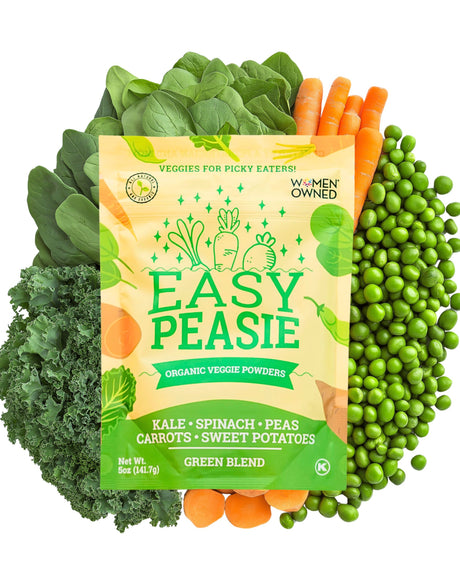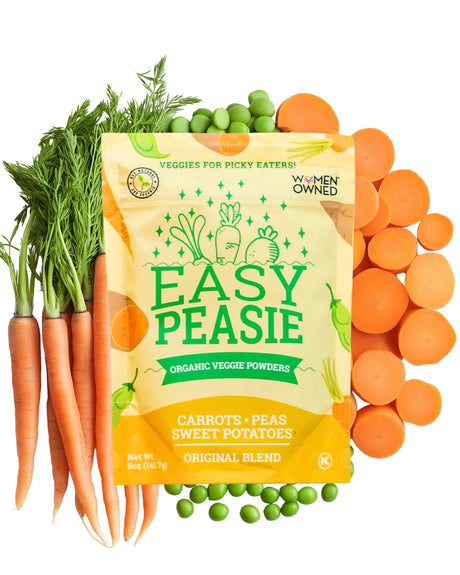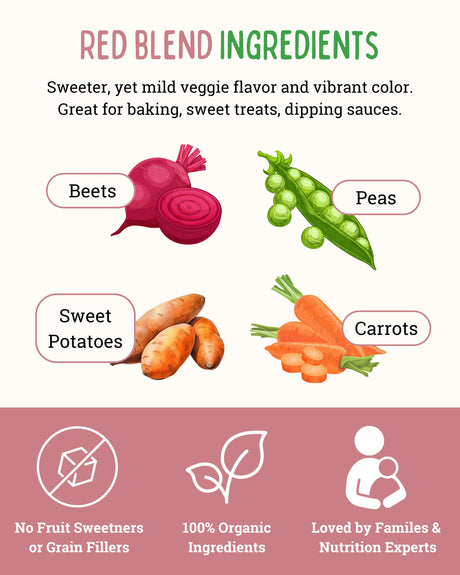The Picky Eater Dilemma
We've all been there, haven't we? One day, your little one is gobbling up broccoli like it's candy, and the next, they're pushing it away with a look of sheer disgust. It's a dance many parents know all too well, and it can feel like a never-ending battle at the dinner table.
Veggies: A Cornerstone of Nutrition
But here's the thing, amidst the food standoffs and culinary negotiations, we can't lose sight of one crucial fact: vegetables are paramount in a child's diet. Packed with essential vitamins, minerals, and fiber, these colorful delights lay the foundation for lifelong health and well-being.
They're not just side dishes to be negotiated over; they're nutritional powerhouses that play a starring role in your child's growth and development. So, how do we bridge the gap between the importance of veggies and the discerning tastes of our little ones? Let's dive in and explore some creative solutions!
Understanding Picky Eating
The Mystery of the Picky Eater
Picky eating is a riddle many parents grapple with, often leaving them scratching their heads in bewilderment. Why does one child devour everything on their plate while another turns up their nose at the same meal?
The truth is, picky eating is a complex interplay of various factors, and it's more common than we might think. In fact, many children go through phases where they're particularly selective about their food choices.
Taste, Texture, and a Rainbow of Colors
Let's break it down a bit. First, there's the matter of taste. Children have more taste buds than adults, making them more sensitive to certain flavors, especially bitterness—a common trait in many veggies.
Then there's texture. Some kids might be put off by the mushiness of cooked carrots or the crunchiness of raw bell peppers.
And let's not forget about color. Children are visual creatures. A plate full of vibrant, varied colors might be more appealing than a monotone meal. Recognizing these nuances in food preferences can be the first step in crafting a strategy to make veggies more enticing to those discerning little taste buds.

The Nutritional Importance of Vegetables
A Treasure Trove of Vitamins and Minerals
Vegetables are nature's multivitamin, offering a diverse range of essential nutrients that our bodies crave. From the vibrant reds of tomatoes packed with lycopene to the deep greens of spinach brimming with iron and calcium, every vegetable brings its unique set of vitamins and minerals to the table.
Think of broccoli, a powerhouse of vitamin C, vitamin K, and fiber, or sweet potatoes, which are a fantastic source of vitamin A and potassium. These nutrients play pivotal roles in various bodily functions, from supporting our immune system to ensuring proper bone health.
Investing in Long-Term Health with Veggies
But the magic of vegetables goes beyond just the immediate nutrients they provide. A diet rich in vegetables lays the foundation for long-term health benefits. Regular consumption of these nutrient-dense foods has been linked to reduced risks of chronic diseases like heart disease, certain cancers, and type 2 diabetes.
Moreover, the fiber in veggies aids digestion, promotes a feeling of fullness, and supports a healthy gut microbiome. By introducing our kids to a variety of vegetables early on, we're not just nourishing their growing bodies but also setting them on a path to a lifetime of healthier eating habits. After all, the choices we make today can shape their health outcomes in the future.
Creative Presentation Ideas
Veggie Art: A Feast for the Eyes
One of the joys of childhood is the world of imagination, and what better way to tap into that than with veggie art? Turn mealtime into a creative session by arranging vegetables into fun shapes and scenes on the plate.
Think of a broccoli forest, carrot stick pathways, or a cauliflower cloud scene. The more interactive and visually appealing, the more likely kids are to dive in. Plus, it's a fantastic way for them to appreciate the beauty of nature's produce.
Veggie Pops: Dip, Crunch, Repeat
Kids love anything on a stick, and veggies are no exception. Create veggie pops by placing vegetable sticks into fun dips like hummus, yogurt, or a homemade ranch.
Not only does this make for a crunchy, delightful snack, but it also gives kids the autonomy to dip and eat at their own pace. Bonus points for using colorful dip bowls to make the experience even more enticing!
Rainbow Plates: A Spectrum of Nutrients
There's something inherently joyful about a plate full of vibrant colors. Embrace the diverse hues of vegetables by creating a rainbow plate.
Red bell peppers, orange carrots, yellow corn, green peas, and purple cabbage can all come together in a visual (and nutritional) symphony. It's a playful way to introduce the concept of eating a variety of nutrients, with each color offering its unique set of benefits.
Stuffed Delights: A Veggie Surprise
Turn vegetables into the main event by using them as vessels for delicious fillings. Bell peppers can be stuffed with a mix of quinoa, beans, and corn, while tomatoes can be filled with a delightful tuna or chicken salad. These stuffed delights are not only nutritious but also offer a mix of textures and flavors, making each bite an adventure.

Veggie Smoothies: Sip Your Greens
For those particularly resistant to the crunch of raw veggies, smoothies offer a fantastic workaround. Blend together vegetables like spinach, kale, or even carrots with fruits like bananas, berries, or mangoes.
The natural sweetness of the fruits masks the veggie flavors, resulting in a tasty drink that's packed with nutrients. Plus, it's a refreshing way to get in those essential vitamins and minerals, especially on warmer days.
Incorporating Veggies in Favorite Dishes
Sneaky Pizzas: A Veggie-Infused Slice
Pizza night is a favorite in many households, and it's the perfect canvas to sneak in some veggies. Consider using vegetable purees like spinach, carrot, or beet as a base for your pizza sauce.
Not only does it add a nutritional punch, but it also gives the sauce a rich, deep flavor. And don't stop at the sauce! Toppings like thinly sliced bell peppers, zucchini, and even roasted cauliflower can be delicious additions.
The key is to keep the flavors complementary and the textures appealing, ensuring every bite is both tasty and veggie-packed.
Pasta Surprises: Noodles with a Twist
Pasta dishes are comfort food at its best. To up the nutritional ante, try mixing in spiralized vegetable noodles with your regular pasta. Zucchini, carrots, and even sweet potatoes can be turned into noodle-like strands that blend seamlessly with spaghetti or fettuccine.
It's a delightful way to introduce a new texture and flavor while still enjoying the familiar comfort of pasta. Plus, it's a colorful addition that makes the dish visually appealing, especially for curious little eyes.

Baked Goods: A Veggie-Packed Treat
Who said veggies can't be part of your sweet treats? Baked goods offer a wonderful opportunity to incorporate vegetables in a subtle way. Think zucchini muffins, carrot pancakes, or even beetroot chocolate bread.
These additions not only provide moisture to your baked goods but also a natural sweetness, reducing the need for added sugars. It's a win-win: kids get to enjoy their favorite treats, and parents can rest easy knowing they're packed with nutritional goodness.
Engaging Kids in the Cooking Process
The Joys of Meal Prep: More Than Just Cooking
Involving kids in meal preparation goes beyond just getting dinner on the table. It's an enriching experience that offers numerous benefits. For starters, it's a hands-on educational opportunity.
Children learn about different vegetables, their origins, and their nutritional values. They also develop essential life skills like measuring, chopping (with supervision, of course!), and following recipes. Moreover, when kids have a hand in making their meals, they're often more inclined to try new foods, especially those veggies they've been avoiding.
Gardening Adventures: From Soil to Plate
One of the most rewarding ways to pique a child's interest in vegetables is by starting at the root of it all - gardening. Fun vegetable gardening projects, like planting cherry tomatoes, radishes, or even herbs, can be a delightful way for kids to connect with their food.
Watching a seed grow into a plant and eventually harvesting it to eat can instill a sense of pride and accomplishment. Plus, there's something inherently exciting about digging in the dirt and watching things grow!
Cooking Together: Family Bonding with a Side of Veggies
Turning cooking into a fun family activity can transform the way kids view mealtime. Whether it's designing their own veggie pizzas, stirring a pot of vegetable soup, or assembling colorful salad skewers, there are countless ways to make cooking engaging for kids.
Playing some music, wearing fun aprons, or even having themed dinner nights (like "Tropical Veggie Night" or "Rainbow Salad Day") can add an element of playfulness. Remember, the goal is to create positive associations with vegetables and cooking, making it a joyful experience for everyone involved.
Tips for Introducing New Veggies
The "One Bite Rule": A Small Step Towards Veggie Love
Every parent has faced the challenge of introducing a new vegetable to a skeptical child. Enter the "One Bite Rule." It's a simple yet effective approach.
Encourage your child to take just one bite of the new vegetable. No pressure for more, just a single bite. This method reduces the intimidation factor and often, that one bite can lead to another, and another.
Over time, this can help in cultivating a taste for the vegetable, or at the very least, reduce resistance to trying it again in the future.
Pairing Power: New Veggies Meet Favorite Foods
Another strategy to make new vegetables more appealing is by pairing them with familiar and beloved foods. For instance, if your child loves spaghetti, introduce zucchini noodles mixed in with their regular pasta.
Or if they're fans of mashed potatoes, try blending in some cauliflower. By combining the unfamiliar with the familiar, you're creating a comfort zone on their plate, making the new veggie less daunting.

Slow and Steady: Gradually Upping the Veggie Ante
Diving headfirst into a plate full of unfamiliar vegetables can be overwhelming for kids. Instead, consider a gradual approach. Start by adding small portions of the new vegetable to their meals.
As they become more accustomed to its taste and texture, you can slowly increase the quantity. This method ensures that the introduction of new veggies is a gentle transition rather than a sudden change, making the experience more positive and less resistant for the little ones.
Addressing Concerns and Setbacks
The Ever-Changing Palate: Embracing Evolving Tastes
It's essential to remember that just as our kids grow and change, so do their taste buds. What they may detest today could become a favorite next month. It's all part of their journey of discovery.
Being patient and understanding that food preferences can shift over time is key. Instead of getting disheartened when they push away a plate of broccoli, remember that next time, they might just ask for seconds.
Steering Clear of the Forceful Approach
While it's natural to want our kids to eat healthily, using forceful tactics can backfire. Pressuring or forcing them to eat something can create negative associations with that food, making them even more resistant in the future.
Instead, aim for a gentle nudge, encouraging them to try without making it a battleground. The dining table should be a place of joy, not stress.
Celebrating the Little Wins: Every Bite Counts
In the journey of making veggies appealing, it's crucial to celebrate the small victories along the way. Did they try a bite of that new vegetable? That's a win! Did they help pick out veggies at the store? Another win!
By focusing on these positive moments and giving praise, you're reinforcing their good choices and boosting their confidence. Over time, these small victories can lead to a lifelong love for vegetables.
The Palate's Adventure: A Lifelong Journey
Raising a child is filled with countless adventures, and expanding their palate is one of the most delightful (and sometimes challenging) ones. As they grow, their tastes evolve, opening doors to a world of flavors and textures. It's a journey of discovery, not just for them but for parents too, as we find joy in their culinary explorations.
Persistence and Creativity: The Dynamic Duo
When it comes to introducing veggies to picky eaters, persistence and creativity go hand in hand. There will be days of triumph and days of gentle setbacks. But remember, every meal is a new opportunity. By continuously experimenting with fun presentations, sneaky incorporations, and engaging activities, we can ignite a spark of interest in even the most veggie-averse child.
A Call to Veggie Exploration
To all the parents out there, don't be disheartened by the occasional turned-up nose or uneaten carrot stick. Instead, see it as an invitation to get more creative, to try a new approach, and to dive deeper into the colorful world of vegetables. By staying informed, being patient, and keeping the fun alive, we can pave the way for our kids to embrace veggies in all their nutritious glory. Let's continue this exploration together, making every meal an adventure in taste!
Leave your comments below; we love to hear from you! And don't forget to follow EasyPeasie for more veggie info and convo on YouTube, Facebook, and Instagram! ~ThePeas













